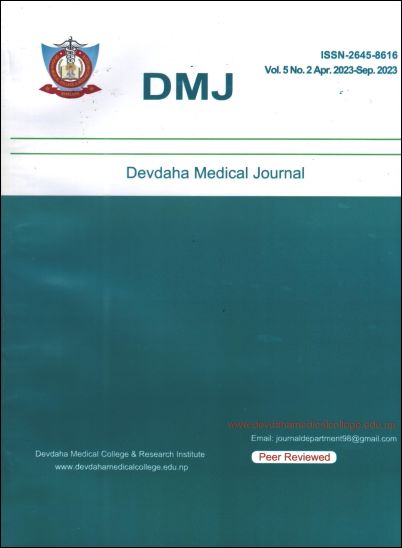Clinical Study on Congenital Birth Defects in a Tertiary Hospital, Western Nepal
DOI:
https://doi.org/10.3126/dmj.v5i2.69795Keywords:
Congenital Birth Defects, Neonatal Intensive Care Unit, NewbornAbstract
Introduction: Congenital Birth Defect (CBD) is one of the commonly encountered problems in neonatal period and major birth defects contribute significantly to neonatal morbidity and mortality. Minor anomalies are frequently seen in newborn which are not detrimental to health but may be associated with major defects serving as a clue for diagnosing more serious underlying defect. Our purpose of study is to determine burden of CBDs, clinical profile and outcome of those neonates born with CBDs admitted in Neonatal Intensive care Unit (NICU) and Obstetric Unit of Devdaha Medical College.
Methods: A hospital based prospective study was performed from 1st Feb 2023 to 30th Sept 2023. All live newborns were screened for birth defect and clinical examination was done every day till discharge. All newborn with CBDs fulfilling the inclusion criteria were taken for study. Maternal characteristics like age, parity, mode of delivery, comorbidities and risk factors were noted. Newborn characteristic like sex, week of gestation, birth weight along with co morbidities (like neonatal sepsis, birth asphyxia) and outcome were noted. Data obtained were coded and entered in SPSS (version 24) for analysis.
Results: The incidence of CBDs was 6.53% with incidence of major defect being 2.5% and minor defect4%. Among all defects, skin anomaly was the commonest defect (30.6%) observed. Among the major defects, musculoskeletal system was the commonest. More than 50% of such babies were born via caesarean section and 1/3rd had low birth weight and nearly 80% were term babies. Among the babies with CBDs, 40% babies had various comorbidities like Neonatal sepsis, birth asphyxia requiring NICU admission and 8% of babies with CBD were referred for surgical correction and 1 (2%) expired.
Conclusion: Congenital malformation is one of the commonly encountered cases (6.53%) among which minor anomaly is more predominant (61.22%) with more than 80% having good neonatal outcome.




